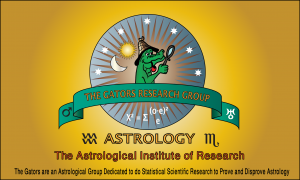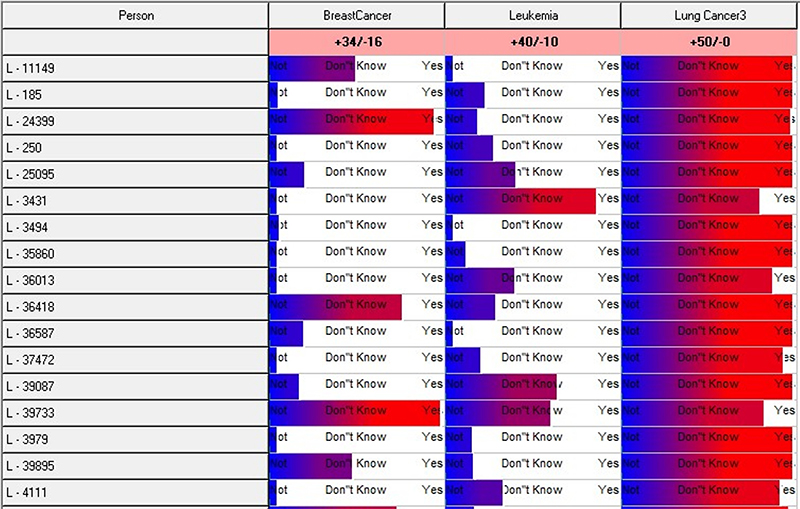
I am involved with a group called the Astrological Investigators or The Gators for short (www.astroinvestigators.com). The Gators are led by a fellow engineer and astrologer Alphee Lavoie. Alphee brings his engineering analytics skills to a field that sometimes can be considered a bit flakey from the scientific community point of view. That is why Alphee has developed research software employing statistical analysis. (www.alphee.com)
The astrological chart is an assessment of a person’s potential in various facets of life including health. The purpose of this study is to determine the astrological characteristics that appear in the birth charts of people who have lung cancer. Once the signature is established it can be used to help predict the potential of the lung cancer in a subject using the birth chart keeping in mind the keyword potential. Obviously, there are other contributing factors that lead to cancer such as lifestyle and stress to name a few but the advantage of knowing if the potential is there then one can adjust their lifestyle. If you have the lung cancer potential in your birth chart, then you should not smoke!
In order to be able to predict cancer based on an astrological chart, we must take into account all factors from sign and house placements of planets to the various aspects. In order to conduct a meaning full study, a sizeable amount of data would be required. For the data to be accurate it had to come from astrologers databases, such that the astrologer has worked with the client. In the end, 50 timed charts were collected. This is not a significant number for a proper scientific analysis what it will do is give us a general indicator. In order to make this a more meaningful study over 300 charts would be required.
THE STATISTICS
In a statistical analysis, one of the key measuring factors is the Chi-Square value. I’m not going to get into that here as you can look that up on your own if you are interested but you’ll have to go back to university statistics for that. What the Chi-Square does is it looks at the factor and measures the occurrence to the expected norm of a group. Consider a herd of sheep. Most sheep are white but there can be black sheep. If you have 10 pairs of white sheep, you have a 25% chance of having a black sheep or 2 or 3. If this season you get anywhere from 1-4 that would be close to the expected result, so you would see a low Chi-square value. Getting 5 black sheep might be an anomaly but if you end up with 6+ then that becomes statistically significant and you will have a higher Chi-square value. You would be dealing with some genetic matter. A Chi-square greater than 3.84 is a significant value.

The lung cancer data consisted of 50 astrological charts. They were analysed using the Air Software (www.alphee.com) module Fast Research to determine the major contributors. A Chi-Square = 2 is considered to be as good as chance, say 50-50. The software was set to list only the contributors that gave a Chi-Square of 3.84 or greater than chance and whether the contributor happened often or seldom. The contributors were listed. In order to determine the Chi-Square, the lung cancer charts were compared against a control group. Seldom occurrences are important as the ones that happen often.
THE RESULTS
Over 200 hundred contributors registered higher than a Chi-Square of 2. The results were tabulated in Table 1. They are broken down into Chi-Square of 10 or greater, Percent probability and whether the aspect occurred seldom or often. Mercury rules the lungs. The table shows Mercury in the top three: Mercury opposite Jupiter (growth, expansion), Mercury out of bounds, and in its rulership. Chiron also factors into the mix. I have also highlighted the 6th house (of illness) influences.
The table below lists the highest contributing factors to lung cancer in the astrological chart.
| POSITIVE EVENTS | CHi SQ. | PROBABILITY | OFTEN/SELDOM |
| Mercury opposite Jupiter | 53.3 | 100% | OFTEN |
| Mercury out of bounds | 29.4 | 100% | OFTEN |
| Mercury in Gemini | 24.4 | 100% | OFTEN |
| Venus parallel Pluto Declination | 22.5 | 100% | OFTEN |
| Chiron in the 4th house | 22.5 | 100% | OFTEN |
| Pluto square Chiron | 22.4 | 100% | OFTEN |
| Jupiter contra parallel Uranus | 22.3 | 100% | OFTEN |
| Jupiter conjunct Pluto | 22.3 | 100% | OFTEN |
| Neptune parallel Pluto | 19.6 | 100% | OFTEN |
| Saturn in Leo | 19.5 | 100% | OFTEN |
| Moon in 2nd house | 19.5 | 100% | OFTEN |
| Saturn rising before the Moon | 19.0 | 100% | OFTEN |
| Saturn opposite Uranus | 16.0 | 100% | OFTEN |
| Ruler of the 6th house in Leo | 16.0 | 100% | OFTEN |
| Vesta in Cancer | 15.8 | 100% | OFTEN |
| Jupiter in Virgo | 14.6 | 100% | OFTEN |
| Pluto speed increasing | 14.6 | 100% | OFTEN |
| Ruler of the 6th house in the 8th house | 13.9 | 100% | OFTEN |
| Saturn in Virgo | 13.7 | 100% | OFTEN |
| Uranus in the 3rd house | 13.5 | 100% | OFTEN |
| Dispositor of Chiron in the 6th house | 13.5 | 100% | OFTEN |
| Ruler of the Ascendant in the 1st house | 13.5 | 100% | OFTEN |
| Moon square Jupiter | 12.6 | 100% | OFTEN |
| Venus sextile North Node | 12.6 | 100% | OFTEN |
| Mars conjunct the Ascendant | 11.9 | 99.9% | OFTEN |
| Moon opposite the Ascendant | 11.7 | 99.9% | OFTEN |
| Sun aspects Pallas Athena | 11.5 | 99.9% | OFTEN |
| Ruler of 6th house in Taurus | 11.4 | 99.9% | OFTEN |
| Uranus in 3rd, 7th, 11th houses | 11.1 | 99.9% | OFTEN |
| Saturn Intercepted | 10.8 | 99.9% | OFTEN |
| Mercury in 2nd House | 10.8 | 99.9% | OFTEN |
| Neptune aspecting 6th house ruler | 10.7 | 99.9% | OFTEN |
| Mars in 2nd house | 10.3 | 100% | OFTEN |
| Mars aspecting 6th house ruler | 10.2 | 99.9% | OFTEN |
| Ascendant in Fire signs | 10.1 | 99.9% | OFTEN |
| Sun conjunct Chiron | 10.0 | 99.8% | OFTEN |
| Moon conjunct Chiron | 10.0 | 99.8% | OFTEN |
The table below lists the highest contributing factors do not lead to lung cancer in the astrological chart.
| EVENT | CHI SQ. | PROBABILITY | OFTEN/SELDOM |
| Pluto Retrograde | 16.3 | 100.0% | SELDOM |
| Neptune sextile Pluto | 14.6 | 100.0% | SELDOM |
| Moon in 1st, 5th and 9th | 12.5 | 100.0% | SELDOM |
| Pluto speed increasing retrograde | 10.9 | 99.9% | SELDOM |
| Sun aspecting 4th house ruler | 10.4 | 99.9% | SELDOM |
| Uranus speed increasing | 10.2 | 99.9% | SELDOM |
| Mercury speed increasing | 10.2 | 99.9% | SELDOM |
NEURAL NETWORK ANALYSIS
The definition of a Neural Network from Wikipedia:
“In machine learning, artificial neural networks (ANNs) are a family of statistical learning algorithms inspired by biological neural networks (the central nervous systems of animals, in particular, the brain) and are used to estimate or approximate functions that can depend on a large number of inputs and are generally unknown. Artificial neural networks are generally presented as systems of interconnected “neurons” which can compute values from inputs, and are capable of machine learning as well as pattern recognition thanks to their adaptive nature.”
It is also called a Black Box model because what happens between the input and output is not known. The Fast Research programme has the capability to take all the contributors from the model based on what occurs often and what occurs seldom and develop a Neural Network which can predict the outcome based on all aspects of the chart.
The figures below show how the model behaves with the lung cancer charts compared to other types of cancer models. Then it is checked with the charts of people who didn’t have lung cancer. As you can see, the model despite having a small sample size produces a somewhat effective model. (Note: L= Lung Cancer).

The model was run against a database of famous people in this case actors. Many of the actors from the database are worldwide and many of the ones that showed signs of cancers did not come up in searches on the web. Of the ones that did we could find on the web, here are the results:
Robert Alba Keith.
Born: November 14, 1921, in Bayonne, NJ, USA
Died: June 24, 1997 (aged 75) in Malibu, CA, USA
His profile on Wikipedia states: “During the latter part of his life, Keith suffered from emphysema and lung cancer despite having quit smoking 10 years earlier (he appeared in an endorsement campaign for Camel Cigarettes in 1955). On June 24, 1997, he was found dead of a self-inflicted gunshot wound…”
![]()
Douglas Osborne McClure.
Born: May 11, 1935, in Glendale, CA, USA
Died: February 5, 1995 (aged 59) in Sherman Oaks, CA, USA
Cause of Death: Lung Cancer”

CONCLUSIONS
Despite not having enough charts for a proper study, the model still was able to predict lung cancer out of a database of actors. We would still need more data in order to refine the model. We are continuing our studies and developing models that can predict various topics such as career, wealth and health.
